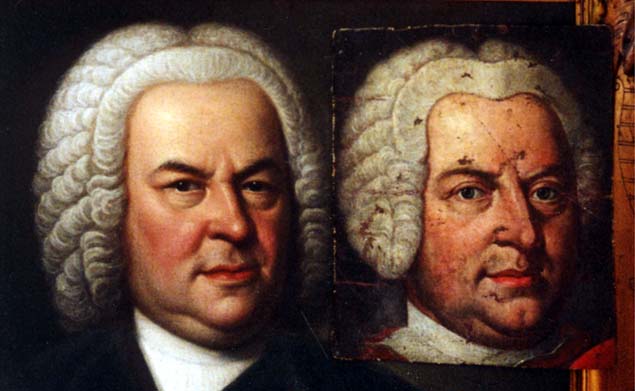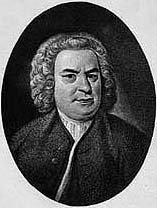The Critical Discographies from Choral Music On Records - Mass in B Minor Pages at the Teri Noel Towe Home Pages
Johann Sebastian Bach
The Critical Discographies from Choral Music On Records
This remarkable photograph is not a computer generated composite; the original of the Weydenhammer Portrait Fragment, all that
remains of the portrait of Johann Sebastian Bach that belonged to his pupil Johann Christian Kittel, is resting gently on the surface
of the original of the 1748 Elias Gottlob Haussmann Portrait of Johann Sebastian Bach.

1748 Elias Gottlob Haussmann Portrait, Courtesy of William H. Scheide, Princeton, New Jersey
Weydenhammer Portrait Fragment, ca. 1733, Artist Unknown, Courtesy of the Weydenhammer Descendants
Photograph by Teri Noel Towe
©Teri Noel Towe, 2001, All Rights Reserved
The Critical Discographies from Choral Music On Records
Mass in B Minor, BWV 232
Mass in B Minor, BWV 232
The 1960s and 1970s
Anthon van der Horst's interpretation was recorded in concert in the Grote Kerk in Naarden, the Netherlands, in the early '60s. [28]
The sound of the very large chorus is rough, and the recording is both badly balanced and muffled. Van der Horst was a musician
much interested in questions of style, and his is one of the first recordings in which the implied, snappy Lombard rhythm is applied
to the flute obligato in the "Domine Deus". Its many virtues notwithstanding, however, the van de Horst recording, like the Fritz
Münch, is valuable primarily as a souvenir of an important and interesting provincial performance.
Hermann Achenbach's recording , which dates from the early '70s, is another worthy provincial performance; there is nothing of the
stellar about it, but it is solid, sensitive, and devoid of pretense or artifice. [29] With reliable soloists and a good medium sized choir
and orchestra, this recording is more satisfying than many of those that have been inflicted on unwary listeners by more renowned
artists.
Like van der Horst's, Walter Goehr's account of the Mass is of Dutch origin; it dates from the mid '60s, and is something of a
mixed bag. [30] A good medium sized chorus and a decent orchestra are sabotaged by poor sound; the balance is unnatural. The
solo quintet is better than average. Pierrette Alarie is cool and detached; Catherine Delfosse's "Laudamus te" is wrecked by Goehr's
painfully slow tempo and gooey interpretation. Grace Hofmann is a fine, plummy alto, and Léopold Simoneau's distinctive, clear
French tenor, so easy and unforced at the upper end, lends particular beauty to the "Benedictus". While he never forces and can
reach all the notes, Heinz Rehfuss sings with a wooly tone and a tight wobble; he was much better in Karajan's first commercial
recording nearly ten years before.
Eugene Ormandy's solid, Central European style reading, which he recorded in 1962 with a large chorus and orchestra, is relatively
straight forward, though by no means devoid of Romantic flourishes. [31] Yet his sincere, no nonsense, modern "symphony
orchestra" approach, which is as appropriate to the Beethoven Missa Solemnis as it is to the B Minor Mass, is always tasteful and
is sullied by no interpretive excesses. The male soloists both have clear, well focussed voices that betray no strain at the top.
Rosalind Elias's contralto is big, with much vibrato. Both she and Eleanor Steber, however, sound comfortable and at home in this
unabashedly twentieth century interpretation of the Mass.
Lorin Maazel's recording , which dates from the early '70s, is neither particularly subtle nor stylish, but his is an enthusiastic, at
times iconoclastic reading. [32] The heavily aspirated and overtly articulated "Laudamus te", for instance, is simply perverse, and
the plodding "Sanctus" is sung with finicky fastidiousness by the well-trained medium sized chorus.
Remakes, as a rule, are rarely as good as or better than first recordings, and that truism proves accurate with respect to the many
instances in which a conductor has tackled the Mass in B Minor twice. One of the few exceptions is Michel Corboz's second
recording. [33] His first account , which features a large chorus, is majestic and patrician, enthusiastic and sensitive as the mood
requires, but the soloists, though adequate, are simply not the equal of those in the later version. [34] While the "Gloria" may not
have quite the same majesty the second time around, it is every bit as colorful, and the Ensemble Vocal de Lausanne turns in
exceptionally fine and beautifully shaded choral work in the "Et incarnatus est" and the "Crucifixus", which are lusciously
atmospheric. The distinctive, well focussed, golden voice of Birgit Finnilä is particularly effective in the "Qui sedes" and the "Agnus
Dei", but José Van Dam is a little somnolent in the "Quoniam".
Otto Klemperer's is an often overlooked and much undervalued interpretation of the Mass in B Minor; it ranks with the 1961
Richter set as the best of the "modern" style recordings. [35] {An unuathorized recording of the October, 1967, concert
performance that preceded the studio sessions was briefly available in the early 1990s; the performance is virtually indistinguishable
from the studio recording. [36]} Klemperer's is a reading of true grandeur and majesty, of Michelangelesque monumentality. The
paradoxical, taut relaxation of the tempos contributes significantly to the aura of radiance and nobility that pervades this dramatic
and emotionally intense account. A top flight chorus, a superb orchestra, and an excellent solo quintet are at one with their
conductor. Gedda is still excellent in the tenor rôle and is arguably more comfortable singing for Klemperer than he was performing
for Karajan nearly fifteen years earlier. Janet Baker sings a forthright, firm, and warm "Laudamus te".
Dame Janet, alas, was in nowhere near as good vocal estate almost a decade later when she sang the same music for Neville
Marriner. [37] In fact, of the four soloists, only soprano Margaret Marshall is in top form. Robert Tear's worn tenor voice makes
for an unpleasant "Benedictus", and Samuel Ramey is uncharacteristically wooly and wobbly. Vocal problems are not restricted to
the soloists; there are some insecure and rough passages in the choruses as well. The whole production seems slightly out of focus,
as if the performers and the conductor were suffering from a collective artistic hangover.
Please click here to advance to Page 8 - The First Period Instrument Recordings.
Please click here to visit the Endnotes Page.
Please click here to visit the Alphabetical Discography Page.
Please click here to return to the Critical Discographies from Choral Music On Records Main Page.
Please click on  to return to the Johann Sebastian Bach Index Page.
to return to the Johann Sebastian Bach Index Page.
Please click on the  to return to the Teri Noel Towe Welcome Page.
to return to the Teri Noel Towe Welcome Page.
teritowe@alumni.Princeton.EDU
Copyright, Teri Noel Towe, 1989, 1997, 2001
All Rights Reserved
The The Critical Discographies from Choral Music On Records - Mass in B Minor Pages at the Teri Noel Towe Home Pages
are PPP Free web pages.

The The Critical Discographies from Choral Music On Records - Mass in B Minor Pages at the Teri Noel Towe Home Pages
have received the HIP Woolly Mammoth Stamp of Approval from The HIP-ocrisy Home Page.